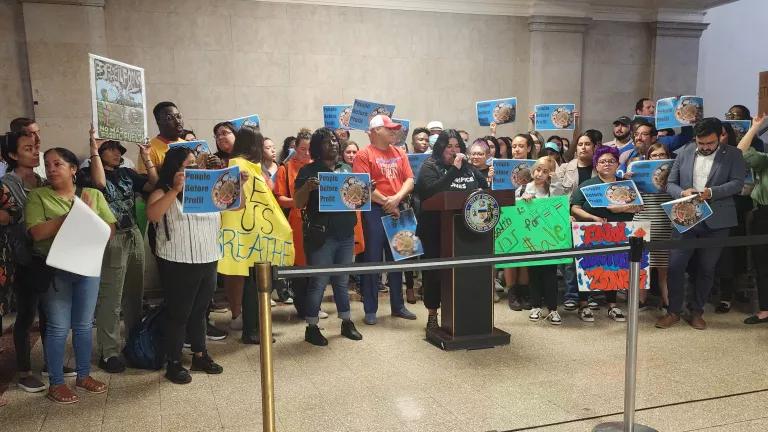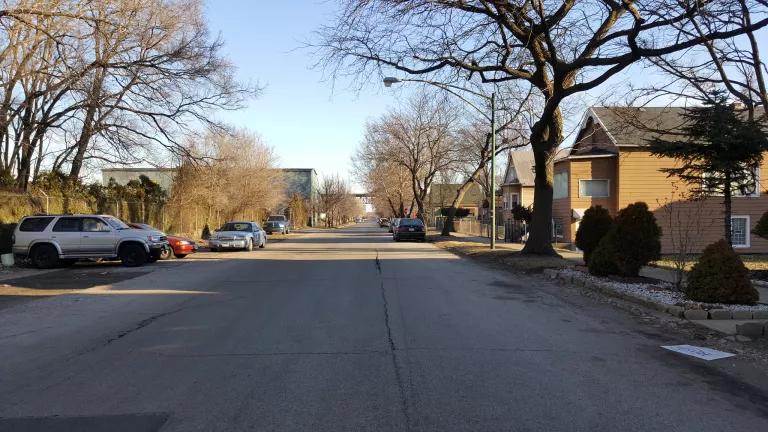Impact of Chicago’s Environmental Justice Executive Order
The executive order is the start of a new stage of work to enact community-led policy reforms in Chicago.

Gina Ramirez speaks to the crowd at a city hall rally on June 6, 2023.
Ivan Moreno/NRDC
The executive order issued by former mayor Lori Lightfoot at the end of her term was the culmination of years of organizing and struggling with the city to recognize how deeply environmental racism affects our communities. The order was designed as part of the voluntary compliance agreement with HUD that I will explain in other blogs. While it’s a new milestone for environmental justice in Chicago, it is also the start of a new stage of work to enact community-led policy reforms.
This order recognizes environmental justice in principle, which means that everyone should have equal protection under environmental laws and regulations. It acknowledges that, historically, communities of color and low-income neighborhoods have been disproportionately affected by unsafe environmental conditions. This is an important recognition because it then leads to the need to address this inequity that has persisted for decades.
It also acknowledges that environmental pollution contributes to chronic illnesses such as asthma and cancer, leading to a huge life expectancy gap between Black and white residents and a reduced life expectancy in the Latine population. In Chicago, the difference between white and Black residents was a decade, which should raise many alarms.
A report by the U.S. Environmental Protection Agency in 2021 confirms that under-resourced communities bear the brunt of climate change impacts and lack the resources to prepare for extreme weather events.
The constitution of the state of Illinois recognizes the right to a healthful environment. The city of Chicago reiterated its commitment to equity for the next 10 years in its We Will Chicago plan, and it has established the offices of Climate and Environmental Equity (OCEE) and Equity and Racial Justice to ensure a healthful environment and to promote racial equity.
To address environmental justice and effectively act on these important recognitions, the city aims to assess cumulative impacts, which refer to the combined effects of various stressors on health and well-being. Chicago's history as an industrial center and its location within a transportation network have resulted in environmental burdens for residents living near industrial facilities, rail yards, waterways, highways, and airports. These burdens have persisted and stacked up on top of each other over time.
The city has been working with community organizations and other experts to assess these cumulative impacts. This executive order is furthering a commitment from the city to identify the communities facing the greatest impacts, involve community groups in decision-making, create evidence-based laws, and ensure that development benefits outweigh the burdens in vulnerable communities.
The document establishes definitions for key terms, including cumulative impact assessment (CIA), environmental justice, and environmental justice action plan. It calls for the formation of an Environmental Equity Working Group and an interagency working group to address environmental impacts and promote environmental justice. These groups will develop an Environmental Justice Action Plan and make recommendations for an ongoing community advisory body.
The city is now bound to complete a baseline CIA by September 2023, which will inform decision-making in areas such as land use, transportation, permitting, and enforcement. The findings of the assessment will be presented to the mayor and the city council’s Committee on Environmental Protection and Energy. The executive order emphasizes public participation, transparency, and protocols for environmental justice engagement.
To coordinate environmental justice efforts, the city will designate an Environmental Justice Project Manager within the OCEE. This manager will work across departments to improve policies and operations, enhance notification processes, establish public participation standards, and address complaints of discrimination.
Overall, this order reflects the years of struggle to get the city of Chicago to commit to environmental justice by recognizing past inequalities, assessing cumulative impacts, and implementing strategies to promote equitable and healthful environments for all communities, but there is still a long way to go. This order addresses the process, but the process is yet to be completed.
Passing a cumulative impacts ordinance will be a crucial step in addressing environmental racism in Chicago. By taking this step, the city can make progress in ensuring that all Chicagoans have a healthy and equitable environment.




